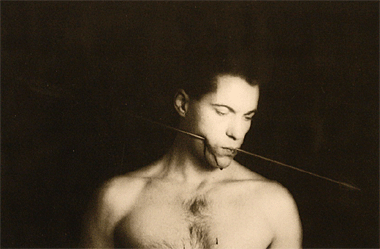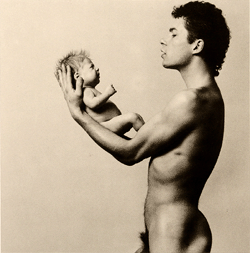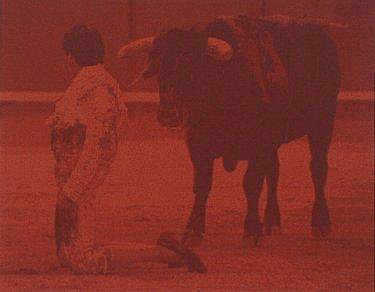1
|
Robert Mapplethorpe:
" Paul Blanca Is My Only Competitor "

|
| Sebastian,1990
|
Paul Blanca (1954/58), official name Paul Vlaswinkel,
is a Dutch art photographer who had a breakthrough in the early 80s of the
last century with his confrontational violent self-portraits influenced
by the great American photographers Robert Mapplethorpe (1946-1989) and Andres
Serrano (1950).The self-taught
Blanca came into touch with the artscene when he met Eva Veldhoen, the
daughter of the well-known Dutch painter Aat Veldhoen (1934). The acquaintance
with this artistic environment was a real eye-opener for Blanca and shortly
after he started photographing, first in color with a small screen camera but
very soon after shooting in B&W using a Hasselblad
camera (6 X 6 cm).
In 1980 he was introduced to the world-famous
choreographer Hans van Manen (1932), who is a meritorious photographer himself
and had a photo studio. Besides their mutual interest in photography, Van
Manen also used Paul Blanca in one of his dance choreographies called Pose in
which Blanca performed as a kick-boxer, he was a practitioner of this
full-contact sport from the age of 16, surrounded by 10 ballerina's.
Robert Mapplethorpe who was a close friend
of Van Manen was very impressed by Blanca's self-portraits and later
introduced him to New York's high society (like Keith Haring, Willem de
Kooning, Japser Johns, Grace Jones...etc.) stating 'Paul Blanca is my only
competitor'.
The art collector Bill Katz says in Anthony Haden Guest's True
Colors - The Real Life of the Art World on Paul Blanca: "...he reaches
a kind of poetry few artists have".
Most of Blanca's self-portraits deal with strong
emotions and violent themes like fear, sadness, pain, agression and sexuality
exploring his inner demons. Diametrically against this harsh work, there are
the sensitive and gentle pictures like the one called Mother and Son (Mapplethorpe's
favourite) depicting himself in a tender embrace with his mother, both fully
naked, or the portrait holding his newborn son in the air called Father and
Son.
In
1986 Blanca worked on a book called Timing ( published in
an edition of 1000 by de Woelrat ) which featured the upcoming
Dutch artists of the eighties and his photographs were accompanied by
poems of Koos Dalstra (1950). For his touching series 'Par la Pluie
des Femmes' (1989) he asked his female models to think of their
most traumatic experiences. Together with Hans Gieles and Francis
Boeske of the gallery Vous Etes Ici he produced the
magnificent Sangre de Toro series in 1991
( see 'Blood of the
Bull' below ). During this time Paul Blanca also started as a
research-journalist for the Amsterdam weekly, Nieuwe Revu and
the newspaper
Het Parool. He wrote about crack and again
exploring his own boundaries he started to use it himself, resulting
in an addiction.
His article for Nieuwe Revu on weapons was the starting point
of a downward spiral with him being a suspect in the assault on Rob
Scholte in 1995 because of his "knowledge" of grenades.
There was a long silence but in 2008 Blanca returned with a project
called Mi Mattes in which he photographed gangmembers hanging
around his studio.
|

|
|
Selfportrait, Father and Son,
1984
|
|
Paul Blanca's
Self-portraits
Over the years there seems to be an increasing
will-power in Blanca's self-portraits. In 1982 he photographed himself With
Eels holding six living eels in his mouth (in his perception a disgusting
animal), he looks at the viewer with a resigned facial expression like he's
thinking "that's how it really goes" with the scavengers fulfilling
his wish to immortalization. In Paul Blanca's Selfportrait, Back with Mickey
Mouse, the large depiction on his back inflicted with a razor blade by a
befriended tattoo-artist, of Mickey Mouse with his thumbs up and a big smile,
like he's saying: "Keep up the good work", is an ironical statement
because the mouse is crying. In his Selfportrait Bull (198.) Blanca
becomes, with his painted body disguished as a bull and his agressive facial
expression, a disturbed figure. With his erected penis in his left hand and
his right hand in a clenched grip, he's looking for an exertion disarming the
poetic image. The excessive nature of Blanca's self-portraits serve as a
purification and therefore he has to subvert all boundaries and norms.
|
Paul Blanca's
Blood of the Bull
|

|
Paul
Blanca who had lived and worked in Spain for two years
(in the early 90s), had, while there, become obsessed by bullfighting and kept
up with all the ferias (local seasonal festivities) to take
photographs. To challenge himself emotionally Blanca also participated in a
bullfight, not with real bulls but with dangerous vacas (cows) of 850
pounds. It intrigued him that when the corrida (bullfight) was at an
end, the bull's meat was served in restaurants but nothing was done with the
blood- it is the fluid of life, after all. Blanca investigated whether blood
could be used as silk-screen printing-ink. The treated blood was used for the Sangre
de Toro port-folio (see picture!), based on Blanca's photos. Pressing the
ink through the screen only once produced no more than a light pink colour,
and in the end 35 'pulls' were needed to achieve the darkest tone in the
pictures, creating a deep embossing. The series forms a high point on the
periphery of Blanca's photographic work. For the affecionades
(devotees) it is a must, for opponents of bullfighting it is also a monument
of beauty.
Pictures
of
Paul Blanca's
>
Sangre de Toro
port-folio.
A
recommended source on Paul Blanca (mainly Dutch) is the
>
Rob Scholte
Museum.
|
|